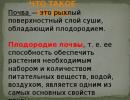Presentation on the surrounding world "what kinds of soils there are." Presentation "What is soil
Structure and
soil structure

What is soil?
The soil- This is a loose surface layer of land that has fertility.
Soil fertility, i.e. its ability to provide plants with the necessary set and amount of nutrients, water, air, is one of the most basic properties of soil.

For a long time there was an opinion that soil is rock.
This theory was refuted by the Russian scientist Vasily Vasilyevich Dokuchaev, who proved that soil is “a special natural-historical body, the result of the interaction of the organic and inorganic world.”
He was the founder of the science of soil science.
Vasily Vasilievich Dokuchaev

Soil formation
The process of soil formation is very slow,
Over 100 years, a soil layer of only 0.5 cm to 2 cm is formed.
Stage 3
Microorganisms produce humus from the remains of plants and soil animals (larvae, worms). Sand and clay are soil-forming rocks, and with humus (humus) they become soil.
Stage 1
It begins with the process of weathering (destruction) of rocks. With the help of wind, sun and precipitation, mountain ranges are destroyed. In turn, the breakaway boulders are broken down into small particles (sand, clay, limestone).
Stage 2
Microorganisms, the first plants and lichens, the seeds of which are carried by the wind, settle on destroyed rocks.


Basic soil properties
Fertility
Mechanical
Structure
soils
soil composition
soils

Soil structure
Soil structure – the ability of soil particles to combine into relatively stable lumps.
The shape, size and strength of these lumps are not the same in different types of soil.
The best is grainy , or fine-lumpy (diameter of lumps 1-10 mm.)

Mechanical composition of soils
- Clayey, loamy (heavy); do not allow water to pass through well
- Sandy, sandy loam (light); easily pass water

Soil structure
Structural soils (particle diameter up to 10 mm): lumpy, granular
Structureless (particle diameter up to 0.05 mm): dusty
Soil structure
important for the development of vegetation.
It ensures the permeability of air, moisture, nutrients

Densely permeated with roots. This includes dead above-ground parts of plants, which are processed by microorganisms, worms, larvae and insects. This is where humus is formed. The humus horizon is the darkest
Soil structure
A leaching horizon from which a significant portion of organic and mineral compounds has been removed. This horizon is very bright. A podzolic horizon is formed here.
Washout horizon. It receives what the upper part of the soil loses.
Slightly altered parent rock from which soil is formed

Soil structure
By structure soil profile , that is, according to the degree of expression of individual horizons, their thickness and chemical composition, they determine whether the soil belongs to a certain type, for example: chernozem, podzolic and etc.


Living organisms in soil
- Soil is the habitat for many organisms. Creatures that live in the soil are called pedobionts. The smallest of these are bacteria, algae, fungi and single-celled organisms that live in soil waters. Up to 10 organisms can live in one m³.
- Invertebrate animals such as mites, spiders, beetles, springtails and earthworms live in the soil air. They feed on plant remains, mycelium and other organisms. Vertebrates also live in the soil, one of them is the mole. It is very well adapted to living in completely dark soil, which is why it is deaf and almost blind.

The importance of soils in nature Soil as a habitat for living organisms
- The soil is fertile - it is the most favorable habitat for the vast majority of living beings - microorganisms, animals and plants .
- It is also significant that according to them biomass The soil (land of the Earth) is almost 700 times larger than the ocean, although land accounts for less than 1/3 of the earth's surface.

Ecological significance of soil
- Soil is often called the main wealth of any state in the world, since about 90% of humanity's food is produced there and in it.
- Degradation soils is accompanied by crop failures and famine, leads to poverty of states, and soil destruction can cause the death of all humanity. Earth was also used in ancient times as a building material.

1.Which soil formation factor is the main one?

2. What is soil fertility?
The ability of the soil to produce high crop yields
The ability of the soil to provide plants with the necessary set and amount of nutrients, water, air

3. The very first soil horizon is...
mother breed
humus
eluvial (washing in)

4.Which soil property is most important?
structure
mechanical composition
fertility

5. How long does it take to create soil with a layer of 1-2 cm?

Literature
- Ivlev A.M. Evolution of soils. - Vladivostok. 2005.
- Orlov D.S. Humic acids of soils. – M, 1974.
- Kononova M.M. Soil organic matter. – M, 1963.
- Alexandrova L.N. Soil organic matter and the processes of its transformation - L,: 1980.
- Trofimov S.S., Taranov S.A. Features of soil formation in technogenic ecosystems // Soil Science. 1987.

Subject : What is soil.
Lesson Objectives :
- Study the composition of the soil
- Identify the basic properties of soil
- Find out about the prevailing soils of your native land
Prepared the presentation
Eliseeva Irina Vitalievna
Primary school teacher
MAOU secondary school No. 2, Malaya Vishera

What is soil?
What properties does it have?
The shovel said: - earth to dig.
The boots said: - earth to walk on.
And the people said: - land to live.

- Novgorodskaya region- non-chernozem, it is characterized by podzolic soils.





Practical work
Experience 2
Take some blotting paper and sprinkle some soil on it. Press it firmly onto the paper. Shake the soil into a glass of water. What will you see? What does this experience prove?
Experience 1
Take a glass of water and throw a lump of soil into it. What will you see? What conclusion can be drawn?
- There is in the soil AIR .
There is in the soil WATER .


Cycle of substances in nature
Animals
Plants
Dead remains of plants and animals
Humus
Salts
Microbes


Proverbs:
The earth is a plate: what you put in is what you take out.
Good soil will raise more.
To plow deeper means to chew more bread.

Test
1.Choose the correct soil definition
I) the top layer of the earth, where there is sand and clay;
E) the top layer of the earth, where there is sand, clay, air, water;
O) the top fertile layer of the earth;

2. What is the main part of the soil?
T) humus;
D) sand;
B) clay.
3. What is formed from humus under the influence of microbes?
M) water;
H) air;
L) salt.

4. What do plants use for nutrition?
E) microbes;
I) salt;
Yu) humus.
5. What is formed from the remains of dead plants and plants under the influence of microbes?
Ш) sand;
Sh) clay;
H) humus.

6. Water can wash away a layer of soil of 18 cm in 500 thousand years, in a meadow - in 3225 years, and where there are no plants - in just 15 years! What do these scientists’ calculations say?
M) The larger the soil layer, the faster it is washed away by water, no matter what plants grow on this soil.
H) The larger and more branched the root system of plants, the stronger they hold the soil.
K) The smaller the plant roots, the stronger they hold the soil.

7. Which statement is true?
A) Where there are no plants, wind and water cannot disperse and wash away all or part of the soil.
A) If you use more pesticides than normal, the soil will lose its fertility.
I) When a large amount of fertilizer is applied to the soil, excess salts accumulate in it, which leads to an increase in yield.

Write it in the dictionary
the soil
humus
fertility

Lesson summary
What new did you learn?
What did you learn?
When was it difficult?
And when is it interesting?
Thank you for your work!
What types of soils are there?
Tundra soils. The soil does not have time to warm up during the short summer and at a depth of 1.5-2 m a layer of permafrost remains in it, the level of which decreases along river valleys. Tundra soil saturated with moisture is called gley. As a rule, conditions here are unfavorable for tree growth. Mosses and lichens are common; In summer the ground is covered with many low flowering plants.
Podzolic soils The most common type of soil in Russia. They form under coniferous and mixed forests in conditions of excess moisture, which ensures soil leaching during a significant part of the growing season. Podzols are most typical for the middle taiga
Gray forest soils An indispensable condition for the formation of such soils is the presence of a continental climate. Deciduous forest and herbaceous vegetation. The places of formation contain an element necessary for such soil - calcium. Thanks to this element, water does not penetrate deep into the soil and does not erode them. These soils are gray in color. forest soils
Chernozem Chernozem is a highly fertile soil of a characteristic black color, which has a distinct granular-lumpy structure. Chernozem has long been the best soil for farming, formed many years ago under herbaceous vegetation under the influence of certain climatic zones (steppe and forest-steppe
Swamp soils Swamp soils are formed mainly in the middle climatic zone with a humid climate - the taiga zone of Siberia and the Far East, the northwest and north of the European part of the country. At its core, a swamp is an area of land with severe waterlogging and a thick top peat layer of 30 cm or more. The cause of waterlogging can be either too close a location of groundwater or a lack of natural flow during heavy rainfall; A frequent cause is the gradual overgrowing of natural reservoirs with stagnant or low-flowing water.
Meadow soil Meadow soils are found throughout the gray soil zone, in valleys and in river deltas and in the lower parts of foothill slopes. Meadow soils are formed under the vegetation cover represented by the meadow formation, mainly rhizomatous grasses (palmweed, adjerek, reed, reed grass, etc.), vegetating until frost, as well as under tugai forests with poplar, oleaster, and tamarisk. The soil-forming rocks of meadow soils are layered fine-earth and pebble alluvial, deltaic and proluvial deposits. A necessary condition for the development of meadow soils in the gray soil zone is soil periodic or constant capillary moistening of the soil profile. The groundwater level lies at a depth of 1-2.5 m.
To use presentation previews, create a Google account and log in to it: https://accounts.google.com
Slide captions:
Soil formation and diversity Geography teacher: Savolainen N.A. School No. 292 St. Petersburg
Lesson plan How soil is formed Structure of soil Properties of soils
What is soil? Soil is a loose surface layer of land that is fertile. Soil fertility, i.e. its ability to provide plants with the necessary set and amount of nutrients, water, air, is one of the most basic properties of soil.
For a long time there was an opinion that soil is rock. This theory was refuted by the Russian scientist Vasily Vasilyevich Dokuchaev, who proved that soil is “a special natural-historical body, the result of the interaction of the organic and inorganic world.” He was the founder of the science of soil science. Vasily Vasilievich Dokuchaev
Soil formation Stage 1 Begins with the process of weathering (destruction) of rocks. With the help of wind, sun and precipitation, mountain ranges are destroyed. In turn, the broken boulders are broken down into small particles (sand, clay, limestone). The process of soil formation is very slow; in 100 years, a soil layer of only 0.5 cm to 2 cm is formed. Stage 2 Microorganisms, the first plants and lichens, the seeds of which are brought by the wind, settle on the destroyed rocks. Stage 3 Microorganisms produce humus from the remains of plants and soil animals (larvae, worms). Sand and clay are soil-forming rocks, and with humus (humus) they become soil.
Where does soil formation begin? What rocks are most common in Russia? How does relief affect the process of soil formation? What effect does groundwater level have on soils? What climate components influence the process of soil formation? What is the rate of soil formation? What role do plants and animals play in soil formation?
Soil fertility Mechanical composition of soils Structure of soils Basic properties of soils
Soil properties Soil structure is the ability of soil particles to combine into relatively stable lumps. The shape, size and strength of these lumps are not the same in different types of soil. The best is granular, or finely lumpy (diameter of lumps 1-10 mm.)
Mechanical composition of soils Clayey, loamy (heavy); poorly permeable to water Sandy, sandy loam (light); easily pass water
Soil structure Structureless (particle diameter up to 0.05 mm): silty Structural soils (particle diameter up to 10 mm): cloddy, granular Soil structure is important for the development of vegetation. It ensures permeability of air, moisture, nutrients
Densely permeated with roots. This includes dead above-ground parts of plants, which are processed by microorganisms, worms, larvae and insects. This is where humus is formed. The humus horizon is the darkest leaching horizon, from which a significant part of organic and mineral compounds has been removed. This horizon is very bright. A podzolic horizon is formed here. Washout horizon. It receives what the upper part of the soil loses. The slightly altered parent rock from which the soil was formed. Soil structure
Soil structure According to the structure of the soil profile, i.e., according to the degree of expression of individual horizons, their thickness and chemical composition, they determine whether the soil belongs to a certain type, for example: chernozem, podzolic, etc.
Soil map of Russia
1. What is soil? 2. List the factors of soil formation. 3. How do soils differ in their mechanical composition? 4. Name the main property of soil. 5. Why should the soil be loose? 6. If there are no earthworms in the soil, what does this mean? 7. How can you determine the age of the soil from soil horizons?
a b C 1. What soil formation factor is the main one? climate relief people
a b C 2. What is soil fertility? The ability of the soil to produce high yields of agricultural crops The ability of the soil to provide plants with the necessary set and amount of nutrients, water, air high humus content
a b C 3. A1 is the horizon... the parent rock is humus eluvial (washing in)
a b C 4. Which soil property is the most important? structure mechanical composition fertility
a b C 5. How long does it take to create soil with a layer of 1-2 cm? 100-200 years 300-400 years 500-1000 years
Description:
This presentation talks about soil, its varieties, the reduction of cultivated areas, and the depletion of fertile lands.The relevance of the issue is due to the need for careful handling of natural resources, in connection with the global problem of anthropogenic and natural destruction of the soil layer.
The purpose of the presentation is to give a general idea of the soil as potential fertile land, favorable for the development and conduct of agriculture, to explain the importance of protecting natural resources and the danger of depletion of fertile layers due to the consequences of industrial activity and natural erosion.
The presentation can be used by a geography teacher as a teaching aid to expand the boundaries of their students’ knowledge about current problems of soil destruction, as well as by students at home to independently study this topic, since the presentation contains accessible theoretical information, presented in understandable language, supplemented by diagrams and illustrations.
The presentation covers the following issues:
- What is soil.
- Types of fertile lands (depending on the amount of humus) - from tundra gley to meadow-chernozem.
- Soil formation formula.
- Soil destruction as a result of improper use - wind erosion, industrial development, waste heaps.
Category:
Slides:
Information:
- Date of material creation: February 05, 2013
- Slides: 12 slides
- Presentation file creation date: February 05, 2013
- Presentation size: 2216 KB
- Presentation file type: .rar
- Downloaded: 1280 times
- Last downloaded: December 12, 2018, at 10:28 am
- Views: 4892 views






